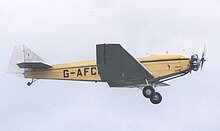British Aircraft Manufacturing
The British Aircraft Manufacturing , formerly British clamping Airplane Company was a British aircraft manufacturer from Hanworth , Middlesex . The company, based at London Air Park , was founded in the early 1930s for the purpose of recreating sports aircraft from Klemm Leichtflugzeugbau GmbH .
history
Terminal had with the 1927 out brought 25 Klemm Kl developed a light sport aircraft, which sold well on foreign markets. Since the aircraft in the United Kingdom found numerous customers, responsible for the UK retailer Major decided EF Stephen building a business for the licensed production of this type. The British Klemm Airplane Company developed the British Klemm Swallow from the Klemm Kl 25 . The changes mainly consisted of adapting to British dimensions and standards. However, numerous customers at Klemm had also criticized the inadequate exchangeability of spare parts, which resulted from the more manual production at Klemm . Stephen tried to adjust the design and manufacture to improve the dimensional accuracy of the parts and thus interchangeability and to meet British airworthiness standards. The prototype of the Swallow , equipped with a Pobjoy R engine, had its maiden flight in November 1933. The Salmson 9 , also an air-cooled radial engine , was also used in the series. In 1935, an improved version of the type called Swallow II came out.
The company's first in-house design was the British Klemm Eagle developed by G. Handasyde . The aircraft, similar to the Klemm Kl 32 , but equipped with a retractable landing gear , had its first flight at the beginning of 1934. A machine of this type took part in the MacRobertson air race from London to Melbourne in 1934 . The pilot, flight lieutenant. G. Shaw , however, had to give up the race at Bushir . Aircraft of this type also took part in some races in the King's Cup Race between 1935 and 1937 and in the Schlesinger Race between England and South Africa in 1936. The improved Eagle II appeared in 1935 along with the Swallow II . In the same year the company was renamed British Aircraft Manufacturing .
The British Aircraft Cupid , published in 1935, was a two-seater training aircraft with side-by-side seats, but only a prototype was created. The British Aircraft Double Eagle , launched in 1936, was not very successful either. Only three examples of this twin-engine airplane with six seats were built. A Double Eagle also took part in the 1936 Schlesinger Race, but just like the Eagle , it was unable to finish the race. Since the company could not establish a successor for the Swallow and the Eagle on the market, it stopped production at the end of the 1930s.
Planes
- British Klemm / British Aircraft Swallow
- British Klemm / British Aircraft Eagle
- British Aircraft Cupid
- British Aircraft Double Eagle
Individual evidence
literature
- AJ Jackson: British Civil Aircraft since 1919 Volume 1 . Putnam, London 1973, ISBN 0-370-10010-7 .
- Dr. Peter Korell: England-Australia - The longest air race in the world . In: Flieger-Revue extra. Edition 6, Müller Buch und Zeitschriften Verlag, 2004.

